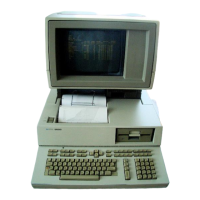2-12
Theory
of
Operation
Processor Stack
The processor stack
is
a 32-bit computer system that controls
all
computer operations. The stack
consists of an enclosing
and
supporting case, up to 12 boards, stack motherboard,
and
clock board.
The boards may
be
finstrates or polystrates.
Finstrates are copper-cored cards with NMOS-III chips bonded to them. Finstrates provide the
combined functions of cooling
fins
and
ceramic substrates.
Polystrates (from polyimide and finstrate) are polyimide boards without the copper core. However,
copper heat sinks are mounted on the circuit side of the board, to dissipate heat from the chips.
All
boards plug into the common Memory Processor Bus
(MPB),
provided on the mother board
(Figure 2-7).
The case has a door that can be
opened
to provide access to the upper 9 slots or removed to
provide access to
all
12 slots. A dc box fan attached to one end of the stack provides cooling air to
the boards.
The stack interconnects with the computer motherboard via two 25-pin connectors
and
a 50-
conductor input/output processor (lOP) cable. The 25-pin connectors
on
the bottom of the stack
interconnect with connectors on the computer motherboard when the stack
is
positioned
in
the
computer. These connectors provide power and control signals. The internal
lOP ribbon cable
connects to the
lOP finstrate
in
slot
#2.
Stack Configurations
The stack has 12 slots numbered from 1 to 12, with slot # 1 the bottom slot
and
slot # 12 the top.
All
slots are interconnected by the memory processor bus via the stack motherboard. The Memory
Processor Bus (MPB), which has 32 data/address lines and 12 control lines, interconnects
all
boards
to the
lOP finstrate(s). The lOP
fin
strate
in
slot
#2
is
connected to the internal lOP cable which
is
routed to the motherboard.
Four types of boards can be used
in
the stack: central processor unit (CPU), input/output processor
(lOP),
and
random access memory
(RAM).
A load board may also be required, depending
on
stack
configuration.
All
are described
in
the following paragraphs.
The stack can
be
configured with various combinations of boards. One or two CPU finstrates can
be added.
One
or two lOP finstrates can be added. Any number of
RAM
boards are allowed.
However,
if 1 Megabyte
RAM
boards are used, they must
be
used
in
pairs.
The following rules must be observed
for
all
configurations:
• Slot # 1 must always contain a CPU finstrate.
• Slot
#2
must always contain an lOP finstrate.
• If there
is
one
additional lOP finstrate,
it
must be contained
in
slot
#3.
If there are two
additional
lOP finstrates, they must
be
contained
in
slots
#3
and
#4.
• No empty slot
is
permitted between two finstrates.
• 1 Megabyte
RAM
boards must be used
in
pairs
(2,
4,6,8,
or 10).

